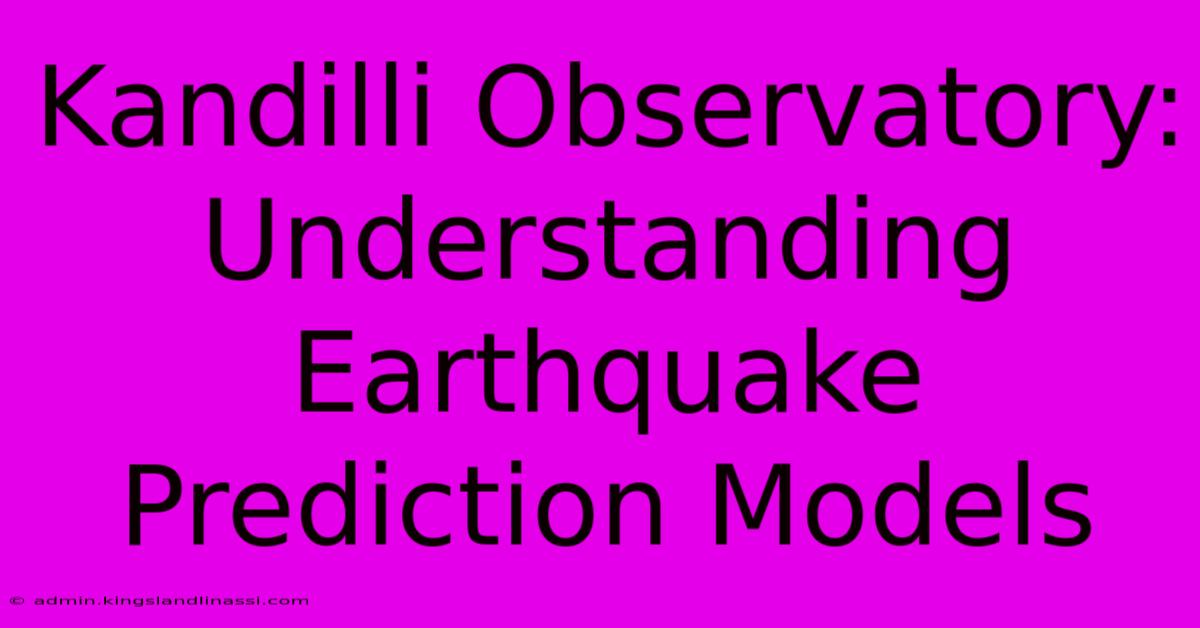Kandilli Observatory: Understanding Earthquake Prediction Models

Table of Contents
Kandilli Observatory: Understanding Earthquake Prediction Models
The Earth's restless nature constantly reminds us of the powerful forces at play beneath our feet. Earthquakes, unpredictable and devastating, remain one of humanity's greatest challenges. For over a century, the Kandilli Observatory and Earthquake Research Institute in Istanbul, Turkey, has stood as a vital center for monitoring seismic activity and advancing our understanding of earthquake prediction models. This article delves into the crucial work of Kandilli Observatory and explores the complexities of predicting these powerful natural events.
The Role of Kandilli Observatory in Earthquake Monitoring
Kandilli Observatory, a globally recognized institution, plays a multifaceted role in earthquake monitoring and research. Its primary functions include:
- Real-time seismic monitoring: A vast network of seismographic stations across Turkey provides continuous data on ground motion, allowing for rapid detection and location of earthquakes. This immediate information is critical for disseminating early warnings and facilitating disaster response efforts.
- Data analysis and interpretation: Kandilli's team of scientists meticulously analyzes seismic data, identifying patterns, magnitudes, and depths of earthquakes. This detailed analysis contributes to a growing body of knowledge about earthquake behavior and regional seismic hazards.
- Developing earthquake prediction models: While perfectly predicting earthquakes remains elusive, Kandilli researchers actively contribute to the development of advanced models. These models leverage statistical analysis, geological data, and sophisticated algorithms to assess seismic risk and improve forecasting capabilities.
- Public education and outreach: Kandilli Observatory plays a key role in educating the public about earthquake preparedness, safety measures, and the importance of understanding seismic risks. This outreach is vital for mitigating the impact of future earthquakes.
Challenges in Earthquake Prediction
Despite significant advancements in seismology, accurately predicting earthquakes remains a significant scientific challenge. Several factors contribute to this difficulty:
- Complexity of fault systems: The Earth's crust is a complex network of interconnected faults, making it difficult to pinpoint the precise location and timing of future ruptures.
- Lack of complete understanding of earthquake mechanics: While substantial progress has been made, scientists still have incomplete knowledge of the physical processes that trigger earthquakes.
- Limitations of current monitoring technology: Although seismographic networks are sophisticated, they may not always detect subtle precursory signals that might indicate an impending earthquake.
Kandilli's Contribution to Earthquake Prediction Models
Kandilli Observatory employs a variety of approaches in its pursuit of improving earthquake prediction:
- Statistical analysis of historical data: By analyzing historical earthquake records, scientists can identify patterns and trends that may help predict future events.
- Geodetic measurements: Techniques like GPS and InSAR (Interferometric Synthetic Aperture Radar) measure ground deformation, providing insights into the build-up of stress along fault lines.
- Geophysical studies: Research into the Earth's structure, composition, and physical properties contributes to a more comprehensive understanding of earthquake mechanisms.
- Development of early warning systems: Kandilli Observatory is instrumental in developing and implementing effective early warning systems that provide crucial seconds or minutes of warning before strong shaking begins. This time can be life-saving.
The Future of Earthquake Prediction
While perfect earthquake prediction remains a distant goal, continued research and advancements in technology offer hope for improved forecasting. Kandilli Observatory, through its unwavering commitment to research, data analysis, and public education, is playing a vital role in shaping the future of earthquake preparedness and risk mitigation. The ongoing development of sophisticated models, combined with advanced monitoring networks, offers the potential for significantly enhancing our ability to anticipate and respond to these powerful geological events. The work of the Kandilli Observatory is not just about understanding earthquakes; it's about safeguarding lives and communities.
Keywords: Kandilli Observatory, Earthquake Prediction, Earthquake Monitoring, Seismic Activity, Istanbul, Turkey, Earthquake Research, Seismology, Earthquake Models, Early Warning System, Seismic Hazard, Fault Lines, Geophysics, Geodetic Measurements, Disaster Preparedness.

Thank you for visiting our website wich cover about Kandilli Observatory: Understanding Earthquake Prediction Models. We hope the information provided has been useful to you. Feel free to contact us if you have any questions or need further assistance. See you next time and dont miss to bookmark.
Featured Posts
-
The First Year A Photographic Celebration Of My Daughter
Apr 21, 2025
-
My Moms Smile My Happiness
Apr 21, 2025
-
Endricks Age A Sign Of Things To Come
Apr 21, 2025
-
Iu Age Embracing Change And Growth
Apr 21, 2025
-
Speed Youtuber Age Behind The Scenes
Apr 21, 2025
